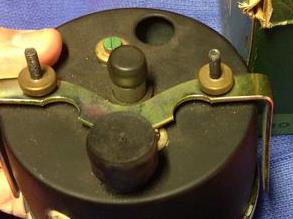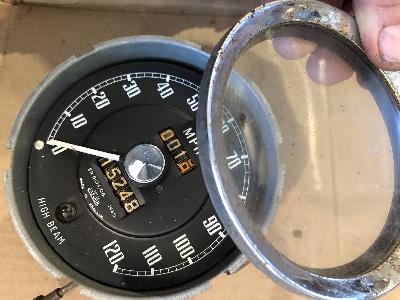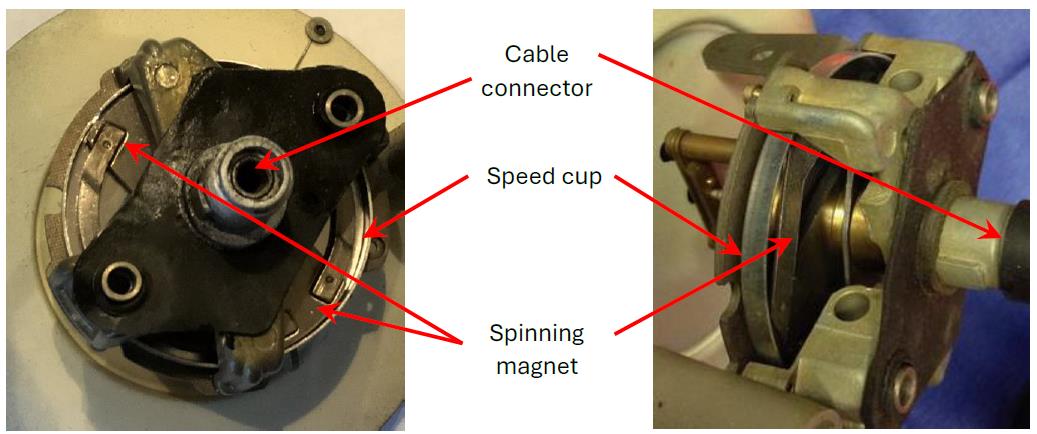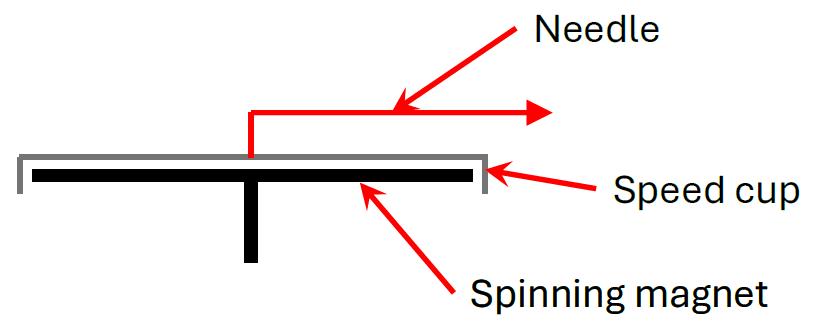
© 2024 British Car Club of Charleston. All Rights Reserved.
There are many ways in which a speedometer or tachometer will fail. The most often is the cable. In my case, the tachometer needle would occasionally rapidly swing nearly all the way. It would then go back to the correct position. This is not the same as the needle oscillating within a range. This is another issue that I will touch on at the end of this article. While driving it seemed to be getting worse, so I reached under the dash and unscrewed the cable from the tachometer. I decided it was time to try to fix it. Removing the tach from the dash of an MGA is actually pretty easy. First unplug the two lights from the rear. Then unscrew the two brass thumb wheels at the back. The bracket holding the tachometer to the dash can now be removed from the rear and the tachometer removed from the front. Next, grab the bezel and rotate the tachometer housing just a small amount so the tabs align with the spaces in the housing. The bezel and the glass can now be removed.
Now unscrew the two screws holding the internals to the housing. Take care when doing this. Hold the internals by the cable connector at the rear. Holding the tach face side up with a finger on the cable connector, push the internals out of the housing.
When holding the internals, hold them from the cable connector or the frame. Do not hold them from the tachometer face or the speed cup at the rear.
The tachometer and speedometer operate the same. The spinning cable coming from the transmission (speedometer) or engine (tachometer) screws to the cable connector shown below. The cable is directly connected to the spinning magnet. The magnet spins inside the speed cup. The speed cup is directly attached to the needle. There is a watch type spring attached to the speed cup that returns the needle to the zero position. There is a small gap between the spinning magnet and the speed cup.
Now unscrew the two screws holding the internals to the housing. Take care when doing this. Hold the internals by the cable connector at the rear. Holding the tach face side up with a finger on the cable connector, push the internals out of the housing.
When holding the internals, hold them from the cable connector or the frame. Do not hold them from the tachometer face or the speed cup at the rear.
The tachometer and speedometer operate the same. The spinning cable coming from the transmission (speedometer) or engine (tachometer) screws to the cable connector shown below. The cable is directly connected to the spinning magnet. The magnet spins inside the speed cup. The speed cup is directly attached to the needle. There is a watch type spring attached to the speed cup that returns the needle to the zero position. There is a small gap between the spinning magnet and the speed cup.



As the magnet spins, it creates a rotating magnetic field which, in turn, drags the speed cup and its attached needle in the same direction as the magnetic field – without a physical connection. "Without a physical connection" is a key point in my problem. The gap is very small and if anything gets between the speed cup and magnet, it will rotate the speed cup. This is what was happening to mine. You can put a small screwdriver in the cable connector and spin the magnet, making the speed cup rotate. Occasionally I could hear a noise and the speed cup would rotate excessively. I could see very small particles attached to the magnetic. Using a can of brake cleaner, I gently sprayed some between the speed cup and magnet. I then gently sprayed it with compressed air. For both, I gently held the speed cup from rotating. Again, using the screwdriver, I spun the magnet and there was no longer an unexpected rotation of the speed cup. I put the tachometer together and put it back in the car. Success, the tachometer was steady as a rock.
Another very common problem is when the tachometer or speedometer needle oscillates within a range. For instance, you would be going 60mph and the needle swings between 50 and 70. As mentioned earlier, there is a watch type spring which returns the needle to the zero position. In your car suspension, when a shock absorber goes bad, you can push down on a fender and the car will bounce several times before stopping. This is because the damping (shock absorber) is bad. This is what is happening with the needle. If there is no damping, the needle can become unstable and oscillate. It doesn’t take much to create damping. I put one drop of clock oil on the shaft between the speed cup and needle. This solved the problem. Added damping doesn’t change where the needle position is. It only changes how long it takes to get there. So, this does not change the calibration.
Another very common problem is when the tachometer or speedometer needle oscillates within a range. For instance, you would be going 60mph and the needle swings between 50 and 70. As mentioned earlier, there is a watch type spring which returns the needle to the zero position. In your car suspension, when a shock absorber goes bad, you can push down on a fender and the car will bounce several times before stopping. This is because the damping (shock absorber) is bad. This is what is happening with the needle. If there is no damping, the needle can become unstable and oscillate. It doesn’t take much to create damping. I put one drop of clock oil on the shaft between the speed cup and needle. This solved the problem. Added damping doesn’t change where the needle position is. It only changes how long it takes to get there. So, this does not change the calibration.

Jaeger Speedometer and Tachometer repairing
















